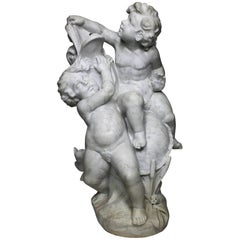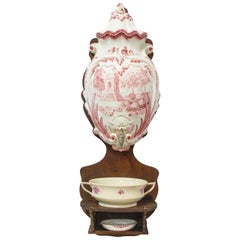Louis XV Fountains
The style of 18th-century French furniture was guided by the court. When Louis XV, who reigned from 1715–74, focused royal life on the smaller salons of Versailles rather than its grand chambers, it transformed the aesthetics away from the imposing and angular furniture that characterized the style of Louis XIV. A broader focus on comfort and more delicate forms define antique Louis XV furniture, with nature-inspired carvings, wood inlays, curved cabriole legs, asymmetrical shapes and rounded oval seat backs. The furnishings changed throughout the king’s life, as he ascended to the throne as a child and then grew to establish his own tastes.
Pieces like the bergère, an upholstered armchair with a wide cushion that fit the flowing dresses in fashion at the time, reflected this more informal court. Introduced at the start of Louis XV’s reign, bergère chairs in this style were deeper and broader than other chairs of the period.
Louis XV tapestries and carpets tended to be floral and colorful, and design elements were borrowed from Asia. Dutch-born cabinetmaker Bernard van Risenburgh brought lacquer techniques influenced by Japan and China into his luxuriously made furniture. Along with its fine details, the furniture of the era also featured new innovations including mechanical devices. Jean François Oeben, a royal cabinetmaker, created such intricate pieces as a mechanical table for Madame de Pompadour, Louis XV’s mistress. It involved a sliding top and a writing surface that extended from its marquetry panels.
During the later years of Louis XV’s reign, there was a shift from the ostentatious rocaille style, part of the exuberantly decorative Rococo movement in Europe for which designers such as Nicolas Pineau and Juste-Aurèle Meissonier are known. The style under Louis XVI would return to boxier forms, but with a neoclassical touch inspired by the ancient world.
Find antique Louis XV bedroom furniture, seating, tables and decorative objects on 1stDibs.
Early 1900s French Antique Louis XV Fountains
Marble
19th Century Antique Louis XV Fountains
Marble
Mid-19th Century French Antique Louis XV Fountains
Chestnut, Faience
19th Century French Antique Louis XV Fountains
Bronze
Early 19th Century Portuguese Antique Louis XV Fountains
Marble
Early 19th Century French Antique Louis XV Fountains
Iron
19th Century European Antique Louis XV Fountains
Marble
1820s French Antique Louis XV Fountains
Iron
Late 19th Century French Antique Louis XV Fountains
Marble, Bronze
1850s French Antique Louis XV Fountains
Sandstone
16th Century Italian Antique Louis XV Fountains
Carrara Marble
20th Century North American Louis XV Fountains
Granite, Metal, Copper
Early 1600s Italian Antique Louis XV Fountains
Marble


